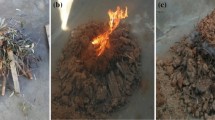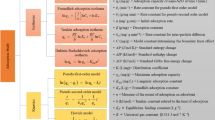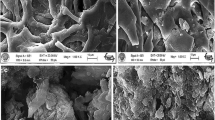Abstract
The removal of copper ions, from synthetic solutions, using walnut shell and olive pomace waste as biosorbents was studied. Synthetic copper solutions were used, and the contact time, initial pH, biosorbent dose, and initial concentration of copper ions were evaluated. The used particle size of both biosorbents was inferior to 600 µm. In the elimination of copper ions, the walnut shell reached 88% (30 min), and the olive pomace 86.5% (40 min). The maximum removal of copper ions was at pH 5 with both biosorbents. The elimination of copper ions was constant with increasing doses of bio-sorbent; however, a decrease close to 90% in the biosorption capacity was determined, when the dose of biosorbent increased from 1 to 10 g/L. The effect of the biosorption capacity increased proportionally with the initial concentration of copper ions; achieving biosorption of 8.3 and 12.9 mg of Cu+2/g of biosorbent, with walnut shell and olive pomace, respectively. Both biosorbent allowed copper ions removal close to 90%; however, to the olive pomace was not necessary a size reduction and had a higher copper ions biosorption capacity than the walnut shell.
Resumen
Se estudió la remoción de iones cobre desde solución sintética, usando cáscara de nuez y orujo de oliva como biosorbentes; se evaluó el tiempo de contacto, pH inicial, dosis de biosorbente y concentración inicial de iones cobre. El tamaño de partícula usado de ambos biosorbentes fue inferior a 600 µm. En la eliminación de iones cobre, la cáscara de nuez alcanzó 88 % (30 min) y el orujo de oliva 86,5 % (40 min). La máxima remoción de iones cobre fue a pH 5 con ambos biosorbentes. La eliminación de iones cobre fue constante con dosis crecientes de biosorbente; pero, se determinó una disminución cercana al 90 % en la capacidad de biosorción, cuando la dosis de biosorbente incrementó de 1 a 10 g/L. El efecto de la capacidad de biosorción aumentó proporcionalmente con la concentración inicial de iones cobre; obteniéndose biosorción de 8,3 y 12,9 mg de Cu+2/g de biosorbente, con cáscara de nuez y orujo de oliva, respectivamente. Ambos biosorbentes permitieron una remoción de iones cobre cercana al 90%; sin embargo, el orujo de oliva no necesitó reducción de tamaño y tuvo mejor capacidad de biosorción de iones cobre que la cáscara de nuez.













Similar content being viewed by others
References
Al-Asheh, S. M. R., & Banat, F. (2001). Adsorption of zinc and copper ions by the solid waste of the olive oil industry. Adsorption Science and Technology, 17(2), 117–129. https://doi.org/10.1260/0263617011494024
Banerjee, M., Bar, N., & Das, S. (2021). Cu(II) removal from aqueous solution using the walnut shell: Adsorption study, regeneration study, plant scale-up design, economic feasibility, statistical, and GA-ANN modelling. International Journal of Environmental Research, 15(2), 875–891. https://doi.org/10.1007/s41742-021-00362-w
Basci, N., Kocadagistan, E., & Kocadagistan, B. (2004). Biosorption of copper (II) from aqueous solutions by wheat shell. Desalination, 164(2), 135–140. https://doi.org/10.1016/S0011-9164(04)00172-9
Cano, M. (2015). Caracterización de aceite de oliva virgen elaborado en zonas oleícolas de Extremadura. Doctoral thesis. Universidad de Extremadura. Extremadura, España, pp. 180
Caviedes, D. I., Muñoz, R. A., Perdomo, A. P., Rodríguez, D. R., & Sandoval, I. J. (2015). Tratamientos para la remoción de metales pesados comúnmente presentes en aguas residuales industriales. Revista Ingeniería y Región, 13(1), 73–90. https://doi.org/10.25054/22161325.710
Dakroury, G. A., Abo-Zahra, Sh. F., & Hassan, H. S. (2020). Utilization of olive pomace in nano MgO modification for sorption of Ni(II) and Cu(II) metal ions from aqueous solutions. Arabian Journal of Chemistry, 13(8), 6510–6522. https://doi.org/10.1016/j.arabjc.2020.06.008
De Los Santos, C., Fernández, J., Barajas, J., Pérez, G., Hernández, M. A., & Díaz, L. L. (2019). Adsorption of copper (II) and cadmiun (II) in aqueous suspensions of biogenic nanostructures CaCO3. Boletín de la Sociedad Española de Cerámica y Vidrio, 58(1), 2–13. https://doi.org/10.1016/j.bsecv.2018.05.003
Dionisio E. (2012). Aprovechamiento de residuos vegetales para la eliminación de cobre presente en medios acuosos mediante biosorción. Documento. Universidad de Granada, España. pp. 250, URI: http://hdl.handle.net/10481/23727.
Ebrahim, S. E., & Rasheed, F. A. (2013). Removal of Copper Ions onto walnut shells by using batch and continuous fluidized bed. Journal of Engineering, 19(8), 978–991.
Fernández-González, R., Martín-Lara, M. A., Blázquez, G., Tenorio, G., & Calero, M. (2020). Hydrolyzed olive cake as novel adsorbent for copper removal from fertilizer industry wastewater. Journal of Cleaner Production, 268, 121935. https://doi.org/10.1016/j.jclepro.2020.121935
Gondaf, Y., Boriky, D., Elkouali, M., Talbi, M., Moubarak, F., Salamat, A., & Ouzidan, F. (2018). Removal of copper (II) ions from aqueous solution by adsorption on activated carbon prepared from shell walnuts. International Journal of Scientific & Engineering Research, 9(10), 1006–1011.
Kamar, F., & Nechifor, A. C. (2015). Removal of copper ions from wastewater using walnut shells as a natural adsorbent material. UPB Scientific Bulletin, Series B, 77(3), 141–150.
Khiari, B., Wakkel, M., Abdelmoumen, S., & Jeguirim, M. (2019). Dynamics and kinetics of cupric ion removal from wastewaters by tunisian solid crude olive-oil waste. Materials, 12(3), 365. https://doi.org/10.3390/ma12030365
Menichi, A., Chagraoui, A., Nadi, N., Moussaoui, A., Tairi, A., Ahmed, Ait Sidi, & O., Loubbidi, L. (2015). Kinetic and thermodynamic studies on adsorption of Copper (II) ions onto the olive pomace lignocellulosic in the region of Beni Mellal (Morocco). Journal of Mater Environmental Science, 6(12), 3443–3451. ISSN : 2028-2508.
Meza, Y.R. & Mallaupoma, L.A. (2018). Adsorción de iones Cu(II) desde soluciones acuosas utilizando nano arcillas. Tesis de Ingeniería Química. Universidad Nacional del Centro de Perú. Huancayo, Perú, 74 pp. In Repositorio.uncp.edu.pe/ bitstream/handle/ UNCP/3775/MezaRamos-MallaupomaMuñoz.pdf? sequence=1&is Allowed=y.
Muñoz, M. (2017). Nueces: Chile la mayor tasa de crecimiento productivo medio anual. Oficina de estudios y políticas agrarias. Informe ODEPA, 10 pp. In enstatic.elmercurio.cl/Documentos/Campo/2017/11/21/2017112111112.pdf.
Murphy, V., Hughes, H., & Mcloughlin, P. (2007). Cu(II) binding by dried biomass of red, green and brown macroalgae. Water Research, 4(4), 731–740. https://doi.org/10.1016/j.watres.2006.11.032
Oyarzo, R. (2019). Remoción de iones cobre desde efluentes sintéticos empleando biosorbentes (p. 51). Tesis de Ingeniería en Metalurgia. Universidad de Atacama.
Pagnanelli, F., Mainelli, S., Veglio, F., & Toro, L. (2003). Heavy metal removal by olive pomace: Biosorbent characterisation and equilibrium modelling. Chemical Engineering Science, 58(20), 4709–4717. https://doi.org/10.1016/j.ces.2003.08.001
Ponnusamy, S. K., Subramaniam, R., Vasanthakumar, S. S. B., Kirupha, S. D., & Sivanesan, S. (2011). Removal of copper(II) ions aqueous solution by adsorption using cashew nut shell. Desalination, 266(1–3), 63–71. https://doi.org/10.1016/j.desal.2010.08.003
Quintelas, C., & Tavares, T. (2001). Removal of chromium (VI) and cadmium (II) from aqueous solution by a bacterial biofilm supporte on granular activated carbon. Biotechnology Letters, 23, 1349–1353. https://doi.org/10.1023/A:1010546101832
Rodríguez, A. (2014). Revisión bibliográfica de sorbentes orgánicos utilizados en la remoción de iones cobre (p. 83). Tesis de Ingeniería en Metalurgia. Universidad de Atacama.
Rojos, S. (2016). Determinación de la dinámica de transferencia de plomo, cobre, arsénico y mercurio en la cuenca del Río Copiapó, Región de Atacama, Chile (Determination of the transfer dynamics of lead, copper, arsenic and mercury in the Copiapó River basin, Atacama Region, Chile. Thesis to obtain the title of Geologist. Department of Geology, pp. 51
Rojos, S., Aguilar, G., Sepúlveda, B., & Pavez, O. (2018). Dinámica de la concentración de cobre, plomo, mercurio y arsénico en sedimentos del Río Copiapó Chile. Revista Internacional de contaminación Ambiental, 35(2), 361–370.
Sepúlveda, B. (2021). Modelamiento hidroquímico con el uso de índices espectrales de la subcuentas Río Huasco y Tránsito, Región de Atacama, Chile (Hydrochemical modeling with the use of spectral indices from the Río Huasco and Tránsito subaccounts, Atacama Region, Chile.). Thesis to obtain the title of Geologist. Department of Geology, pp. 116
Tapia, P., Pavez, O., Garrido, N., & y Sepúlveda, B. (2018). Remoción de iones cobre y níquel con cáscara de maní. Revista HOLOS, 34(3), 57–69. https://doi.org/10.15628/holos.2018.7064
Tapia, P., Santander, M., Pávez, O., Valderrama, L., Guzmán, D., & Romero, L. (2011). Biosorción de iones cobre con biomasa de algas y orujos deshidratados. Revista De Metalurgia, 47(1), 15–28. https://doi.org/10.3989/revmetalmadrid.0917
Tejada-Tova, R. C., Villabona-Ortiz, A., & Garcés-Jaraba, L. (2014). Adsorción de metales pesados en aguas residuales usando materiales de origen biológico. Tecnológicas, 18(34), 109–123. https://doi.org/10.22430/22565337.209
Villaescusa, I., Fiol, N., Martínez, M., Millares, N., Poch, J., & Serarols, J. (2004). Removal of copper and nickel ions from aqueous solutions by grape stalks wastes. Water Research, 38(4), 992–1002. https://doi.org/10.1016/j.watres.2003.10.040
Wang, G., He, L., Wang, M., Tang, S., & Chen, Y. (2020). Enhancing removal of Cu(II) from aqueous solution by walnut shell-based activated carbon with pyrolusite modification. International Journal of Environmental Analytical Chemistry. https://doi.org/10.1080/03067319.2020.1814268
Zare, H., Heydarzade, H., Rahimnejad, M., Tardast, A., Seyfi, M., & Peyghambarzadeh, S. (2015). Dried activated sludge as an appropriate biosorbent for removal of copper (II) ions. Arabian Journal of Chemistry, 8(6), 858–864. https://doi.org/10.1016/j.arabjc.2012.11.019
Acknowledgements
Thanks to the Universidad de Atacama: for the financing and logistical support through the Centro Regional de Investigació para el Desarrollo Sostenible de Atacama (CRIDESAT) and the Instituto de Investigaciones Científicas y Tecnológicas (IDICTEC). Thanks to the Centro de Investigación en Biodiversidad y Ambientes Sostenibles (CIBAS) of the Universidad Católica de la Santísima Concepción, for the professional support and in the management of the project and the publication.
Funding
This article was founded by the Research for the Sustainable Development Regional Center (CRIDESATUDA), Atacama University, Copiapó (Chile). Av. Copayapu 485.
Author information
Authors and Affiliations
Contributions
Not applicable.
Corresponding author
Ethics declarations
Conflict of interest
Not applicable.
Data availability
Not applicable.
Code availability
Not applicable.
Ethics approval
Not applicable.
Consent to participate
All authors participate by consent.
Consent for publication
The authors consent to the publication of these data.
Additional information
Publisher's Note
Springer Nature remains neutral with regard to jurisdictional claims in published maps and institutional affiliations.
Rights and permissions
About this article
Cite this article
Sepúlveda, P., Pavez, O., Tume, P. et al. Biosorption of copper ions with olive pomace and walnut shell. Environ Geochem Health 45, 5713–5726 (2023). https://doi.org/10.1007/s10653-022-01303-y
Received:
Accepted:
Published:
Issue Date:
DOI: https://doi.org/10.1007/s10653-022-01303-y




